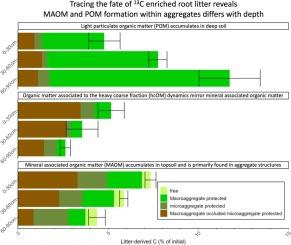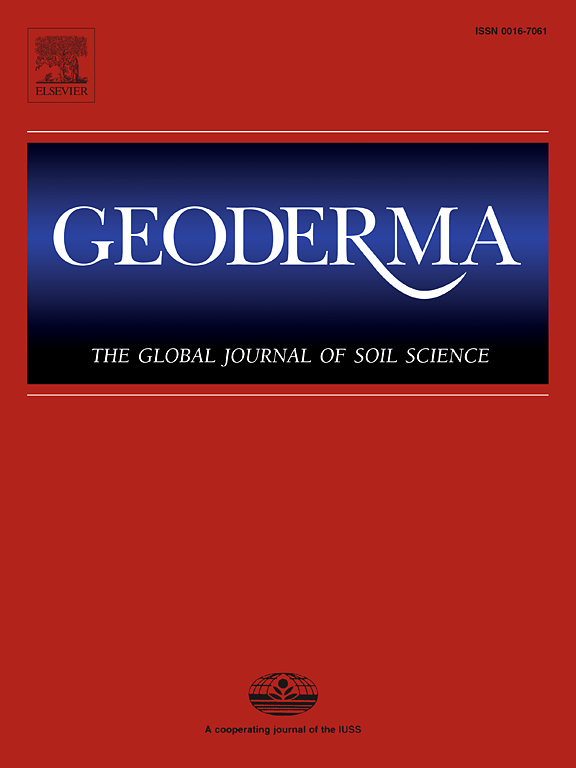Depth impacts on the aggregate-mediated mechanisms of root carbon stabilization in soil: Trade-off between MAOM and POM pathways
IF 5.6
1区 农林科学
Q1 SOIL SCIENCE
引用次数: 0
Abstract
Agricultural practices that promote the formation of soil organic matter (SOM) are considered important climate change mitigation strategies by increasing resilience to climate shocks and promoting soil carbon sequestration. Efforts to increase root production and depth distribution through planting deep rooted crops and selective crop breeding have been identified as a promising strategy to achieve these goals. However, we lack a complete understanding of how the decomposition of roots in the deep soil (e.g., below 30 cm), contributes to SOM formation and stabilization. Here using unique soil-biomass microcosms in the field to trace 13C enriched root litter to a depth of 90 cm, we show that as decomposition dynamics change with depth, so do the SOM formation pathways. At our study site, root residues decomposed faster in the top 0–30 cm, achieving 97 % mass loss by 13 months of incubation compared to 77 % and 81 % in the 30–60 and 60–90 cm depths, respectively. Litter derived carbon (LDC) was preferentially recovered as stable mineral associated organic matter (MAOM), primarily within aggregates, with 67 % more in the 0–30 cm than in the 60–90 cm depth. At depth, root residues decomposed slower and accumulated as the less stable particulate organic matter (POM) within macroaggregates with 145 % more LDC recovered in light POM in the 60–90 cm depth than the 0–30 cm depth. We found that bulk SOM measurements were too coarse to elucidate the likely fate of newly incorporated litter in the soil, but our detailed fractionation demonstrated the relative contribution of new root inputs to functionally different SOM pools, MAOM and POM, and allowed us to interpret the role of microaggregates in these dynamics in new detail, particularly microaggregates within macroaggregates (i.e., occluded microaggregates). Our results highlight the importance of balancing the trade-off between MAOM and POM formation when considering strategies to enhance both carbon sequestration and soil health in agroecosystems. If POM is critical for aggregate formation and microaggregates play an important role in MAOM formation, efforts to increase soil carbon sequestration need to focus on both fractions and on supporting overall soil structure.

深度对土壤中根碳稳定的聚合介导机制的影响:MAOM 和 POM 途径之间的权衡
促进土壤有机质(SOM)形成的农业生产方式可增强对气候冲击的抵御能力,促进土壤固碳,因此被视为重要的气候变化减缓战略。通过种植深根作物和选择性作物育种来提高根系产量和深度分布,已被认为是实现这些目标的一种有前途的策略。然而,我们对根系在深层土壤(如 30 厘米以下)的分解如何促进 SOM 的形成和稳定还缺乏全面的了解。在这里,我们利用田间独特的土壤-生物量微生态系统来追踪富含 13C 的根系残渣至 90 厘米深,结果表明,随着分解动力学随深度的变化而变化,SOM 的形成途径也随之变化。在我们的研究地点,顶部 0-30 厘米处的根系残留物分解速度更快,经过 13 个月的培养,其质量损失率达到 97%,而在 30-60 厘米和 60-90 厘米深处,其质量损失率分别为 77% 和 81%。粪便衍生碳(LDC)主要以稳定的矿物伴生有机物(MAOM)的形式在聚集体中回收,0-30 厘米处比 60-90 厘米处多 67%。在深度上,根残留物的分解速度较慢,在大聚集体中以稳定性较差的颗粒有机物(POM)形式积累,在 60-90 厘米深度上,以轻 POM 形式回收的 LDC 比 0-30 厘米深度多 145%。我们发现,大量 SOM 测量结果过于粗略,无法阐明土壤中新加入的废弃物的可能归宿,但我们详细的分馏结果表明了新的根系输入对功能不同的 SOM 池(MAOM 和 POM)的相对贡献,并使我们能够以新的细节解释微团聚体在这些动态变化中的作用,特别是大团聚体中的微团聚体(即闭塞微团聚体)。我们的研究结果强调了在考虑提高农业生态系统碳固存和土壤健康的策略时,平衡 MAOM 和 POM 形成之间的权衡的重要性。如果 POM 对团聚体的形成至关重要,而微团聚体在 MAOM 的形成中起着重要作用,那么提高土壤固碳能力的工作就需要同时关注这两种团聚体和支持整体土壤结构。
本文章由计算机程序翻译,如有差异,请以英文原文为准。
求助全文
约1分钟内获得全文
求助全文
来源期刊

Geoderma
农林科学-土壤科学
CiteScore
11.80
自引率
6.60%
发文量
597
审稿时长
58 days
期刊介绍:
Geoderma - the global journal of soil science - welcomes authors, readers and soil research from all parts of the world, encourages worldwide soil studies, and embraces all aspects of soil science and its associated pedagogy. The journal particularly welcomes interdisciplinary work focusing on dynamic soil processes and functions across space and time.
 求助内容:
求助内容: 应助结果提醒方式:
应助结果提醒方式:


